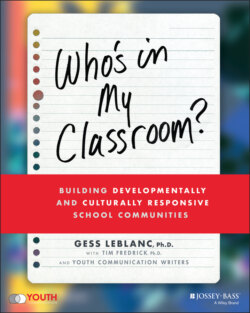Читать книгу Who's In My Classroom? - Tim Fredrick - Страница 20
1. Reflect on your current teaching and disciplinary practices.
ОглавлениеIn “Why Race and Culture Matter in Schools,” UCLA professor Dr. Tyrone Howard recommends that to become more culturally responsive we need to reflect on our responses to key questions, including:
whether there are racial, ethnic, gender, or economic characteristics common to students who are referred for special needs services, gifted education, or AP courses;
how frequently we differentiate instruction;
whether we allow culturally based differences in language, speech, reading, and writing to shape our perceptions about students’ cognitive ability; and
how often we include nontraditional means of assessment (such as role-playing, skits, poetry, rap, self-evaluations, Socratic seminars, journaling, student-led conferences, or cooperative group projects) as part of our assessment practices.
Percy Lujan, 18, attended a school for recent immigrants from countries with widely varying political systems. An important goal for the school was to help students understand American democracy. Here's how one history teacher used creative approaches to deepen student understanding and assess learning:
When we studied the French Revolution, Ms. Sara helped us understand how history is still relevant by making us participate in the class as if we were history's protagonists. She first divided us into groups representing the three estates that existed in France at that time, and then she had members of each group research their assigned estate. We had to write and give a speech in front of the class, expressing the point of view of our estate. Ms. Sara and her assistant acted as Marie Antoinette and King Louis XVI, commenting on the ideas that they “liked” and acting offended about the ideas they didn't. That class discussion made me realize the beauty of democracy and why some people die to obtain it.
In addition to Dr. Howard's questions, I also ask the teachers I support to reflect on whether there are racial, ethnic, gender, or economic characteristics common to students who tend to receive discipline referrals.
Jeimmy Hurtado, 16, describes a classic case of gender-based disciplinary policies:
“You with the spandex, come here.” My principal, who was lounging on the school security desk, motioned with her index finger for me to come forward. My legs stayed glued to the ground as I glanced around at the other students who rushed past me. It took me a moment to register that she was talking to me. I was the only one wearing spandex, but why was she calling me over? Every bad thing I had done immediately popped into my head—such as when I overused the school printer or accidentally took the school's art brushes home without writing my name on the list. I stepped forward.
“Go to the guidance counselor, and pick up a pair of gym shorts,” she commanded.
She stood up and walked through the double doors into the guidance office. I followed her but my mind was elsewhere. I was getting in trouble for wearing leggings?
In my school, getting “gym-shorted” or “gym-shirted” is a punishment imposed on students who disobey the dress code, although I have only seen it imposed on girls.
The Department of Education dress code lists specific types of clothing that are prohibited, like extremely brief or see-through garments. But leggings or spandex are not on the list. I still had to pay $5 for a pair of shorts and experience a day of humiliation.
Although the dress code applies to both boys and girls, it seems to be mostly targeted to girls, which is sexist. Only a few rules actually impact boys, like the “no hats” rule, while the vast majority of rules are clearly intended to police girls’ wardrobes only. How is it fair that boys are allowed to wear muscle tanks that reveal their broad shoulders, while women are restricted from wearing halter tops and tops with spaghetti straps?
Aniqa Tasmin, 17, attended another school in the same district and noticed the same discrepancies.
It seems like it is mostly girls who are called out. I've seen boys wearing offensive shirts that contain explicit sexual language that is demeaning to women and naked photos of women. They often wear muscle shirts to gym class that expose their chests. Yet I haven't known any boys to be “dress-coded.” I have also observed that curvier women of color seem to be penalized for defying the dress code more often than skinny, White females are.
